THE EXHIBITION
The exhibition, promoted by the Fondazione Federico II and the assessorato regionale ai Beni Culturali e all’Identità Siciliana (regional council for the Cultural Heritage and the Sicilian Identity), offers a meaningful selection of important Flemish paintings from public and private Sicilian collections. The prestigious heritage gathered here can be framed in a vast chronologic arch, ranging from the late XV century to the XVII century. The route of the exhibition is articulated according to two strongly intertwined themes: on one hand, the artwork arrived in Sicily through several paths of artistic patronage and collecting; on the other, artists of Flemish and Dutch origins who had been active and completely integrated in the Sicilian historical and social fabric since the central years of the XVI century.
The exhibition has a notable protagonist, an artwork that reveals itself to the public after a silence lasted 32 years: Saint Catherine of Egyptian Alexandria. The martyr is represented on an oak panel (XXI – XXVIII), and was part, together with the panel representing Saint Roch, of a devotional triptych. The author is a Flemish painter, unknown for an obvious reason: the central part of the triptych has been lost and it is therefore impossible to be certain of the artist. Among the artworks exhibited it is remarkable the most famous work of Jean Gossart, also known as Mabuse, which is the Malvagna triptych, a miniature depicting a Madonna with Child and angels, Saint Catherine of Alexandria and Saint Dorothea, while on the back of the panel the coat of arms of the Lanza family can be seen; the Deposition by Jan Provoost, instead, emblematically represents one of the most significant examples of the transition from Gothic to Renaissance in the Netherlands; while from the Chiaramonte Bordonaro collection the Madonna with Child is going to be shown, by Anton van Dyck, Rubens’ apprentice, who in this artwork consolidates the emancipation from his master; another work by Van Dyck is the Crucifixion (private collection Palazzo Alliata di Villafranca) where the genre he created is presented, as an evolution and a personal elaboration of Rubens’ manner, and has obtained, since the beginning, a great success thanks to that combination of dramatic verisimilitude that depicted Christ in the exact moment of death; of high artistic value is also the Circumcision of Simone de Wobreck, an oil on wood where the typical late mannerist pathetic and devotional inclinations can be seen, as well as the predominance of decoration of the composition scheme; no less significant is the presence of Dutch Mattia Stomer with the work The death of Cato, characterized by a voluminous plasticity of the flesh and a strong chromatic impasto.
This type of painting offered a novel figurative notion according to which the minute and lenticular descriptivism of figures, environments and landscapes coordinates with a particular expressive use of color. Since the third decade of the XVI century, Flemish artists encountered the Italian Renaissance and the first mannerist painters, maturing a new composition research of great balance, typical of the paint workshops of Antwerp. Since the early XVII century, the new wave of naturalism inspired by Caravaggio marks a new centrality of Flemish and Duch paintings, in Sicily as well, with van Dyck, Honthorst, Stom e Houbraken.
March 23rd, 2018. After thirty-two years of oblivion, a Flemish artwork has been unveiled in Palermo, depicting Saint Catherine of Alexandria, the Martyr that converted all but her persecutor. The unveiling, organized by the Fondazione Federico II and the Assessorato ai Beni Culturali (Council for the Cultural Heritage), was held in an almost surreal atmosphere in the Monastery that bears the same name as the Saint, in the presence of several military, civilian and diplomatic authorities, among which were the representatives of the Belgian Embassy in Italy.
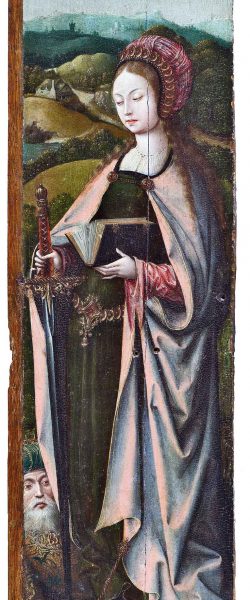
After listening to the Voci Bianche of the Conservatorio di Palermo (Boy Choir of the Palermo Conservatory), silence filled the Church, then the unveiling and the sound of bells to “Welcome back Catherine”. Until today it had been safeguarded in the Convent of the Friars Minor Capuchin in Palermo, from the Church of Saint Jacob, annexed to the convent of the same order, in Bivona.The art work (end of the XV century- beginning of the XVI century, oil on wood, 53,8 x15,3) is a panel, the right door of a dismembered triptych, and has been attributed to the so-called Master of the Legend of Saint Lucy, artist active in Bruges, close to the style of Hans Memling and Gerard David. After the event, “Saint Catherine” has been immediately transferred, with the aid of important security measurements, to the Royal Palace, where it is going to be the protagonist of the exhibition “Sicilië, pittura fiamminga” (“Sicilië, Flemish painting”), which unites for the first time Flemish artworks from public and private Sicilian collections. The exhibition is going to be held in the renewed Halls Duke of Montalto and opens to the public with the inauguration of March 27th at 6 p.m. to continue until May 28th. The Saint depicted, Catherine, is the daughter of aristocrats form Egyptian Alexandria, alive at the time of emperor Maximinus, here represented at her feet. Sentenced to martyrdom with a spiked breaking wheel, she was eventually decapitated with a sword, one of her iconographic attributes.
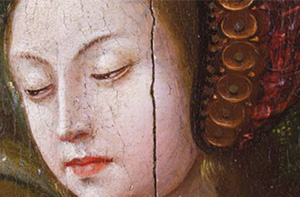
March 23rd, 2018. After thirty-two years of oblivion, a Flemish artwork has been unveiled in Palermo, depicting Saint Catherine of Alexandria, the Martyr that converted all but her persecutor. The unveiling, organized by the Fondazione Federico II and the Assessorato ai Beni Culturali (Council for the Cultural Heritage), was held in an almost surreal atmosphere in the Monastery that bears the same name as the Saint, in the presence of several military, civilian and diplomatic authorities, among which were the representatives of the Belgian Embassy in Italy. After listening to the Voci Bianche of the Conservatorio di Palermo (Boy Choir of the Palermo Conservatory), silence filled the Church, then the unveiling and the sound of bells to “Welcome back Catherine”. Until today it had been safeguarded in the Convent of the Friars Minor Capuchin in Palermo, from the Church of Saint Jacob, annexed to the convent of the same order, in Bivona.
The art work (end of the XV century- beginning of the XVI century, oil on wood, 53,8 x15,3) is a panel, the right door of a dismembered triptych, and has been attributed to the so-called Master of the Legend of Saint Lucy, artist active in Bruges, close to the style of Hans Memling and Gerard David. After the event, “Saint Catherine” has been immediately transferred, with the aid of important security measurements, to the Royal Palace, where it is going to be the protagonist of the exhibition “Sicilië, pittura fiamminga” (“Sicilië, Flemish painting”), which unites for the first time Flemish artworks from public and private Sicilian collections. The exhibition is going to be held in the renewed Halls Duke of Montalto and opens to the public with the inauguration of March 27th at 6 p.m. to continue until May 28th. The Saint depicted, Catherine, is the daughter of aristocrats form Egyptian Alexandria, alive at the time of emperor Maximinus, here represented at her feet. Sentenced to martyrdom with a spiked breaking wheel, she was eventually decapitated with a sword, one of her iconographic attributes.
The Location
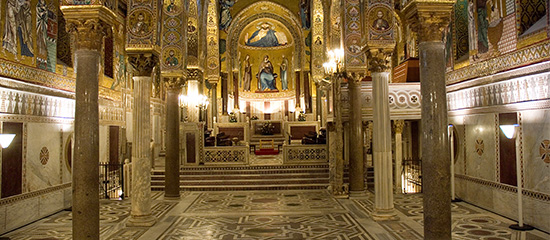
The Royal Palace (Palazzo dei Normanni) is situated in Palermo, and it is the most ancient Royal residence in Europe. Still visible in the dungeons, the remains of the first Punic settlements, but the first structure dates back to the arab domination in the IX century.
The Normans later transformed the Castle into the center of their monarchy and built four towers, connected with porches and gardens. Thanks to Roger II, a magnificent chapel was built inside the palace, the “Palatine Chapel”, dedicated to Saint Peter and Saint Paul and consecrated in 1140. The complex was originally connected to the Cathedral through a covered path. In 1556, after the demolition the towers and the reconstruction of the great façade, it became the residence of the Spanish Viceroys.
The manor was built on two stories: ground floor and noble floor; adjacent to the main building and accessible through designated openings was the chapel; this was decorated with painted architectures created in 1762.
After the Unification of Italy, it became part of the estate of the Military and, with the occasion the national exhibition of 1891 – 1892 the furniture in the royal apartments was renovated. In 1919 the possibility of using the Palace as the location for the academies of the building was proposed by Architect Corrado Anselmi. The exhibition spaces are dedicated to the conservation and presentation to the public of the painting collections and of a selection of graphic artworks.
In the ‘30s of the ‘900, some restorations were made by superintendent to monuments Francesco Valenti, then continued by Mario Guiotto, bringing back some of the Norman structures. Only in 1947 it was named Palazzo dei Normanni (Palace of the Normans) and the associations located there were transferred elsewhere.
The latest restorations took place in 2002, following the damages due to the earthquake. Today the Palace has an important directorial function, as it is the location of the Assemblea Regionale Siciliana (Sicilian Regional Council), but it is also the headquarter of the Astronomic Observatory of Palermo.
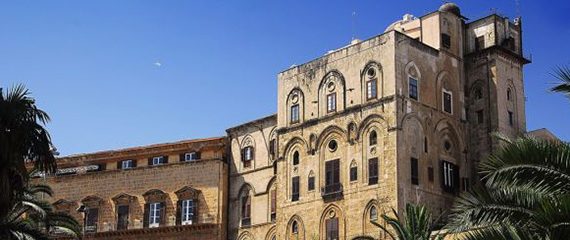
Gallery

Sicily and the Flanders have ancient cultural ties that were fundamental to develop strong relations with the Flemish maritime cities, determining the migration of artisans that moved from the Flanders and Holland to Sicily. The exhibition “Sicilië, pittura fiamminga” (“Sicilië, Flemish painting”) intends to pay homage to this cultural trait d’union between the Mediterranean and the North Sea, uniting for the first time the Flemish painting from public and private Sicilian collections.
Flemish and Dutch artists contribute, therefore, in a meaningful way to Sicilian civilization, fully taking part to the public life and tradition of Sicily, in the period between the XV and XVII century. The choice to present these masters through thematic routes is particularly successful. The invaluable “Malvagna Triptich” by Jan Gossaert, the “Deposizione” by Jan Provoost , the “Madonna with Child” by Anton van Dyck, the “Saint Catherine of Alexandria” kept in Palermo (art work of Flemish workshops, unveiled for the first time) and many other masterpieces, draw a fil rouge which recalls the artwork by Pieter Paul Rubens inspired by Caravaggio, who is also connected to our Island.
A tribute, thus, to the history, at the same time Northern and Mediterranean, of our Island, offered together, with the occasion of the year of Palermo as Capital of Culture, by the Fondazione Federico II, the Sicilian Parliament, the assessorato regionale dei Beni culturali e dell’identità siciliana (regional council for the Cultural Heritage and the Sicilian Identity) and the Embassy of the Kingdom of Belgium in Italy. The monumental complex of the Royal Palace, location of the regionale siciliana (Sicilian Regional Council) and UNESCO site, offers once more a testament of the value of that multifaceted and polycentric civilization of which our island has been notable and original incubator.
Gianfranco Miccichè
President of the Assemblea Regionale Siciliana (Sicilian Regional Council) and of the Fondazione Federico II

“With this exhibition, the Fondazione Federico II officially changes course, adopts a new work method; the vivid and tight collaboration with great the professionals of Culture, private and public, with the assessorato regionale ai Beni Culturali (regional council for the Cultural Heritage) with the objective of offering the best of Sicily and which concludes this expository excursus with the Patron Saint of the city, Saint Rosalia, for Palermo Capital of Culture. Many are the studies and researches on the relationship between Flemish and Italian painters of cities like Rome, Genoa, Venice and Naples. However, still too little is known of the artistically florid and intense tie with Sicilian artists. This exhibition is meant to pay homage to the innumerable traces left on this Island by the relations between Flemish and Sicilian painters. It is an irrefutable fact that the Flemish masters travelled to all of Italy, including Sicily, to admire and study the great artists of the Renaissance and Mannerism. The exhibition is a tribute to the history of Sicily, capable of dialogue with Northern Europe. This land has demonstrated, once more, its ability to offer a propulsive drive to the multifaceted cultural, artistic and economic landscape of Italy. A determining characteristic to attract all those who have been great masters of Flemish painting. And it is this magnificence, this greatness that we recount in “Sicilië, pittura fiamminga” (“Sicilië, Flemish painting”).”
Patrizia Monterosso
Director of the Fondazione Federico II
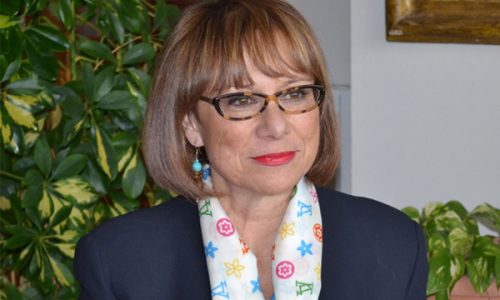
“Sicily deserves love and I have much of it for the Cultural Heritage. I have had the privilege to work in a wonderful field such as the Cultural Heritage administration and to love it as a son. We have carefully worked to catalog the Flemish artworks hosted by museums, Foundations, Churches, Oratories and privates. The following step was to explain to all the subjects to whom these artworks are entrusted the importance and the value of this exhibition dedicated to Flemish art, to the traces left in Sicily by Flemish painters. Art unites all the artists, from Antonello to van Dyck, and this exhibition is evidence that the assessorato regionale ai Beni Culturali e all’Identità Siciliana (regional council for the Cultural Heritage and the Sicilian Identity) and the Region collaborate with the municipality. For the first time we witness a collaboration among three institutions that goes beyond any political appearance. In this bridge of culture ranging from the XV to the XVII century an exhibition of artworks belonging only to Sicily is an unicum in the whole country and shows an invaluable and endless treasure which will necessarily have to open a new phase of management of the treasure of the Cultural Heritage in which economy and art live together. And the reasons for which Sicily has a growing economy are tied, precisely, to art and tourism. In the year of Palermo Capital of Culture, this exhibition represents our crown jewel.”
Marilena Volpes
General director regional department of the Cultural Heritage
INFORMATION
Timetable
Monday/Saturday 8.15 a.m. to 5.40 p.m.
(last ticket 5.00 p.m.)
Sundays/Holidays 8.15 a.m. to 1.00 p.m.
(last ticket 12.15 a.m.)
TICKET PRICE
Only Exhibition
full fare € 6,00
Reduced
Teenagers: 14/17 years € 3,00
Students in school visit € 1,00
Exhibition, Palatine Chapel and Royal Apartments
from Friday to Monday and holidays when Royal Apartments are open
full fare € 12,00 – reduced € 10,00
Exhibition and Palatine Chapel from Friday to Monday
when the Royal Apartments are closed
full fare € 10,00 – reduced € 8,00
Teachers and young people aged between 18 and 25 years are entitled to reduced ticket.
Reduced Ticket Price everyday
Seniors (>) 65 years € 8,00
Teenagers: 14/17 years € 4,00
Students in school visit € 2,00
It is possible to make a RESERVATION for the exhibition visit and Monumental Complex sending an email to fondazione@federicosecondo.org
(info +39 091 6262833)
courtesy translation Elettra La Duca
